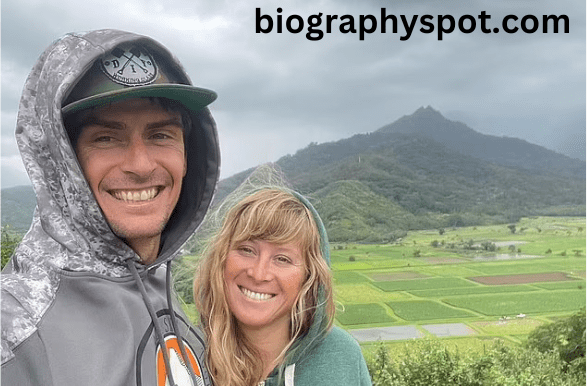Introduction
When you think of fearless climbers, Michael Gardner is one of the first names that come to mind. His story is one filled with strength, thrill, and heart. But like every adventure, his journey took an unexpected turn—one that no one saw coming. Let’s take a closer look at who Michael is and how his love for the climb shaped his life.
A. Overview of Michael Gardner
Michael wasn’t your average adventurer. He stood out for his energy, courage, and kindness. Friends and fans admired his calm attitude, even when hanging off the edge of a cliff.
His Instagram was like a scrapbook of wild peaks and jaw-dropping heights. People followed his climbs not just for the views but because they truly connected with his story.
B. Passion for Climbing and Outdoor Adventures
Climbing was Michael’s happy place. Give him a rope, a helmet, and a mountain—and he was good to go. Nature gave him peace, and the climb gave him purpose.
He wasn’t chasing fame. He just loved to be out there, feeling alive. That passion was real, and it pulled others into the outdoor world with him.
C. The Day That Changed Everything
Then, everything shifted in a moment. A climb like many before suddenly turned tragic. One misstep, one moment—and his world flipped.
News of the Michael Gardner climbing accident spread fast. People were shocked, heartbroken, and desperate for answers. What happened? And how did things go so wrong?
What Happened to Michael Gardner?
The day started like any other for Michael—excited, geared up, and ready to take on another climb. He had done routes like this before. Nothing seemed out of the ordinary. But then, things went terribly wrong.
During the climb, something unexpected happened. Whether it was a slip, loose rock, or weather—it all happened so fast. One moment, he was climbing confidently, and the next, he was falling. The Michael Gardner climbing accident had just happened, and the impact was life-changing.
A. Detailed Account of the Climbing Accident
Witnesses say Michael was halfway through the climb when it occurred. He was steady and calm, as always. But in just a blink, he lost his grip or footing, and everything changed.
He fell a significant distance before landing hard. The silence that followed was chilling. It was clear—he needed help and fast. People nearby rushed into action, and the call for emergency rescue was made immediately.
B. Location and Conditions During the Incident
The climb took place on a rugged, high-altitude trail known for its steep sides and narrow paths. It’s a place loved by pros, but it demands total focus. That day, the weather wasn’t perfect—windy, slightly overcast, and possibly unstable ground underfoot.
Visibility was decent, but the gusts made things risky. Even the best climbers could struggle. It wasn’t the worst day to climb, but it also wasn’t the safest.
C. Eyewitness Reports and First Responders’ Statements
People who saw the fall were stunned. One hiker said it looked like a small stumble turned into a massive drop. Others mentioned how quickly everything happened—no time to react, no chance to stop it.
First responders arrived fast. Rescue teams and medics did all they could at the scene. They later shared how serious his injuries were and how lucky he was to survive. Every second counted—and they made sure none were wasted.
Timeline of the Incident
Michael’s climb started early in the morning. The skies were cloudy, but nothing too alarming. He checked his gear, shared a quick update on social media, and began the ascent. Everything seemed normal.
There was no sign that anything would go wrong. He had done climbs like this before. But as the hours passed, the situation slowly shifted. Something was off—and it all led to one heartbreaking moment.
A. Events Leading Up to the Fall
Just before the fall, Michael was seen checking his gear mid-route. A few climbers nearby said he looked focused and calm. He wasn’t rushing—just taking his time like he always did.
Then, without warning, things changed. He reached for a hold, and that’s when it happened. Maybe the rock gave way, or maybe it was a slip. It was hard to tell. But he fell—and it was serious.
B. Immediate Aftermath and Emergency Response
People around him didn’t waste a second. Some called for help, others rushed to reach him. Climbers and hikers nearby tried to comfort him until the rescue team arrived.
Emergency crews were quick. They had to carry Michael out of a tough spot, and every moment mattered. The scene was tense, emotional, and focused on saving his life.
C. Hospitalization and Medical Reports
Michael was rushed to the hospital in critical condition. Doctors later shared that he had multiple injuries—some life-threatening. His fall had caused serious damage.
He underwent surgery soon after arrival. The medical team said his survival was nothing short of a miracle. They credited the fast response and expert care for keeping him alive.
Causes Behind the Climbing Accident
After the Michael Gardner climbing accident, everyone had the same question—how did this happen? Michael was an experienced climber. He knew the risks, the routines, and the rules. So, what went wrong that day?
Experts, friends, and rescue teams started piecing things together. Several possible factors came up, but no one could point to just one reason. It seemed like a mix of things that led to that heartbreaking fall.
A. Weather and Environmental Conditions
That day, the weather wasn’t ideal. While there wasn’t a full storm, the wind was strong. Gusts pushed through the cliffs, and the air felt unpredictable. That alone can throw even the best climbers off balance.
Also, the trail had some loose rocks and slippery patches. Conditions like that make every step risky. One wrong move on unstable ground can lead to disaster—and sadly, it may have played a part here.
B. Equipment Malfunction or Human Error?
Another possible cause? Equipment failure. There’s no solid proof that his gear broke, but experts didn’t rule it out. Even a small fault in a harness or rope can turn deadly during a climb.
On the other hand, there’s always the human factor. A small mistake, a quick distraction—it happens. And when it does during a climb, the results can be tragic. Michael’s fall may have been a painful mix of both.
C. Safety Measures and Risk Assessment
Michael always followed safety steps, but even the best can’t predict everything. This incident shows how important it is to double-check gear and be aware of your surroundings—always.
Rescue teams said the area had known risks but nothing extreme. It was rated for skilled climbers like Michael. Still, nature can be tricky, and no climb is ever 100% safe.
Injuries Sustained by Michael Gardner
The fall left Michael badly hurt. He didn’t just walk away with a few scrapes—his injuries were serious. When the news broke, fans and friends were heartbroken to hear how badly he was injured.
Doctors shared that the damage was severe. It would take time, care, and a lot of strength for Michael to pull through. But if anyone could fight through pain, it was him.
A. Physical Trauma and Internal Injuries
Michael suffered broken bones, deep cuts, and serious bruises. Some injuries were visible; others were internal. His legs and back took the hardest hit, which made movement painful and risky.
There was also concern about his spine and head. Thankfully, he wore a helmet, which may have saved his life. But even with protection, the impact caused damage that needed immediate attention.
B. Medical Procedures and Surgeries
Michael went through surgery not long after arriving at the hospital. Doctors worked to stop internal bleeding, stabilize his spine, and treat broken bones. It wasn’t just one surgery—he needed several.
Each procedure was a step toward recovery. The medical team stayed hopeful but careful. Every update brought a mix of relief and worry for those rooting for him.
C. Psychological Impact of the Accident
Beyond the physical pain, the emotional weight was heavy. Climbing was Michael’s life—and now, he faced a future full of questions. Would he climb again? Could he?
Moments like this shake a person to their core. Michael had to face fear, doubt, and frustration. But through it all, he stayed strong, knowing that healing takes time—inside and out.
Recovery Journey and Rehabilitation
After the accident, Michael’s fight was far from over. The rescue was just the beginning. What followed was a long road of recovery—filled with small steps, big emotions, and a whole lot of courage.
Healing wasn’t fast or easy. But Michael never gave up. Each day brought new progress, even if it was slow. And every little win meant the world.
A. Initial Recovery Efforts
The first few weeks were all about rest and stability. Doctors focused on pain management, wound healing, and keeping him safe from infection. He was in and out of the ICU and monitored closely.
Michael had to relearn basic movements. Things like sitting up or moving his arms took effort. But from day one, he was determined to fight through it all.
B. Ongoing Physical Therapy
As soon as his body was ready, therapy began. The sessions were tough. They pushed his limits, tested his strength, and often left him exhausted. But they were working.
Day by day, he started to regain control. From lifting his legs to taking short steps with support—it all mattered. His progress was slow but steady.
C. Support from Family, Friends, and Community
Michael wasn’t alone in this journey. His family stood by him every step of the way. Friends showed up with love, laughter, and strength when he needed it most.
Online, the support was massive. The climbing community, fans, and even strangers flooded his socials with kind messages and prayers. That love gave him fuel to keep going.

Public and Media Reaction
When the news broke about the Michael Gardner climbing accident, it didn’t just stay within the climbing community. It spread fast, catching the attention of news outlets, fans, and even people who didn’t know much about climbing.
The public reaction was overwhelming. Social media was flooded with messages of support. Fans and fellow adventurers sent well wishes, hoping for a speedy recovery. The media picked up the story, making sure the world knew how a climber’s passion turned into a fight for survival.
A. Social Media Buzz and News Coverage
On social media, Michael’s story quickly became a trending topic. Hashtags like #PrayForMichael and #MichaelGardnerRecovery were everywhere. People posted pictures of their climbs, which were dedicated to him.
The news outlets followed the journey, too, sharing updates on his condition. With every update, people tuned in, hoping for good news. It was clear that the world cared about this brave climber and was rooting for him every step of the way.
B. Fellow Climbers’ and Outdoor Enthusiasts’ Responses
Climbers from around the world expressed their shock and support. Many shared personal stories about climbing alongside Michael, while others offered advice based on their own experiences. The bond among climbers is strong, and the community came together in the wake of this accident.
Outdoor enthusiasts highlighted how dangerous climbing can be, even for the most experienced. They rallied to raise awareness about safety, vowing to learn from what had happened to Michael. His story sparked a conversation about how the sport can be made safer for everyone.
C. Statements from Rescue Teams or Medical Experts
The rescue teams were praised for their swift and professional response. Their quick action helped stabilize Michael and get him to safety.
Medical experts, on the other hand, were amazed at his survival. They talked about how the fall could have been much worse and credited the medical care he received for saving his life. However, they also stressed how important it is for climbers to follow safety protocols, no matter their experience level.
Safety in Climbing: Lessons from the Accident
Michael’s accident has reminded the climbing world of a crucial lesson: no climb is without risk. Even for the most experienced, the unexpected can happen. But that doesn’t mean we shouldn’t be prepared.
Every adventure is a reminder always to prioritize safety—whether you’re climbing for fun or training for something bigger. The more prepared you are, the better chance you have to handle whatever the mountain throws at you.
A. Importance of Training and Preparation
Training is everything. Michael had years of experience, but that doesn’t mean he didn’t face danger. Climbers need to learn, train, and stay in top shape constantly. It’s not just about physical strength but also mental toughness.
Knowing the terrain, understanding the weather, and practising skills are all part of the equation. The more prepared you are, the less likely you are to be caught off guard. Michael’s story shows that training is key—climbing isn’t something to take lightly.
B. Essential Climbing Gear and Its Role
Having the right gear is another vital part of safety. Michael was always seen with the best equipment, which likely saved his life during the fall. Things like ropes, harnesses, helmets, and carabiners may seem like small details, but they can make a huge difference when it matters most.
Climbers should never cut corners when it comes to gear. Ensuring everything is in top condition and correctly used is part of the preparation process. Michael’s accident highlighted how one piece of equipment could change everything—no matter how experienced you are.
C. How Michael’s Story Is Raising Awareness
Michael’s journey has sparked a wider conversation about climbing safety. His accident opened his eyes to the dangers even the most seasoned climbers face. But it also has inspired many to take climbing more seriously—by training, preparing, and ensuring safety comes first.
Michael’s story is a reminder that the adventure isn’t just about reaching the top—it’s about doing it safely. And as his recovery continues, so does the conversation about how to make climbing a safer, more responsible sport for everyone.
Impact on the Climbing Community
Michael’s accident has had a significant ripple effect on the climbing community. What happened to him served as a stark reminder that even the most experienced climbers face risks. It brought everyone together to rethink safety standards and the way they approach their climbs.
In the aftermath, there has been a noticeable shift in how climbers talk about safety. The conversation isn’t just about how to climb better but how to climb safer—and Michael’s story is at the heart of that change.
A. Calls for Stronger Safety Regulations
In response to the accident, there has been a growing call for stronger safety regulations in climbing. Experts and enthusiasts alike are pushing for clearer guidelines on training, gear checks, and risk assessment.
The climbing community wants to ensure that accidents like Michael’s are fewer and far between. Many believe that more structured safety measures—such as mandatory training and more thorough equipment inspections—could help prevent future tragedies.
B. Inspirational Messages and Support Initiatives
Despite the severity of the accident, Michael’s story is one of inspiration. It’s about perseverance, the will to keep going, and the strength to rise after a fall. Climbers and outdoor lovers have been sending messages of hope, reminding Michael—and everyone—of the power of resilience.
Support initiatives have popped up across the community, with people donating to organizations that promote climbing safety. The goal? To ensure that Michael’s story helps others avoid similar accidents while encouraging safer practices across the board.
C. Events or Foundations Inspired by Gardner’s Story
In honour of Michael, several climbing events and safety-focused foundations have been created. These gatherings not only raise awareness but also provide climbers with tools to improve safety. They’re a way of turning a tragic event into something positive—pushing for change and saving lives.
Michael’s experience has left an unforgettable mark on the climbing world. His story serves as both a cautionary tale and a beacon of hope for climbers everywhere. The community’s response to his journey is proof that we can always find light, even in the darkest moments.
As we explore Michael Gardner’s incredible story of survival and recovery, it’s clear that many individuals leave a lasting impact on the world. Just like Thomas Boone Quaid, whose life and legacy inspire millions, Michael’s resilience and determination remind us of the power of perseverance.
Conclusion
Michael Gardner’s climbing accident has not only been a remarkable tale of survival but also a call to action for the climbing community. His journey through adversity, recovery, and the lessons learned along the way continue to inspire climbers and outdoor enthusiasts alike. Michael’s story emphasizes the importance of safety, preparation, and resilience, reminding us that every climb, no matter how experienced we are, comes with risks.
As we reflect on his journey, it’s clear that his impact reaches far beyond the climbing world, inspiring individuals from all walks of life to face their challenges head-on and never give up. Michael Gardner’s accident may have changed his life, but it has also changed the way we think about safety, training, and the power of community support.
Let his story be a reminder to us all: no matter the obstacles, perseverance, awareness, and support can turn even the most difficult moments into opportunities for growth and change.In light of Michael Gardner’s accident, it’s crucial to be aware of safety practices when engaging in outdoor sports. For climbers, resources like the Climbing Magazine offer great tips on improving climbing safety and reducing risks.
FAQs
-
Who was Michael Gardner?
Michael Gardner is a passionate climber known for his love of outdoor adventures. He gained attention after surviving a serious climbing accident, which left him with multiple injuries. His story has since inspired climbers worldwide to rethink safety and training.
-
What is the most common cause of death in rock climbing?
The most common cause of death in rock climbing is falls, often due to equipment failure, human error, or environmental factors. Proper training, experience, and safety gear can help minimize these risks.
-
What American climber died in the Himalayas?
Several American climbers have tragically lost their lives in the Himalayas. One well-known case is that of George Mallory, though it’s debated whether he reached the summit of Mount Everest before he perished.
-
What is the indoor climbing accident rate?
Indoor climbing is generally safer than outdoor climbing due to controlled environments and regular equipment checks. However, accidents still occur, with the most common injuries being sprains, fractures, and rope burns.
-
Who is Michael Gardner’s father?
As of now, there is no public information widely available about Michael Gardner’s father.
-
Who is the CEO of Gardner Rich?
The CEO of Gardner Rich, a prominent investment firm, is Cheryl Gardner. The firm is well-known for its work in investment management and business consulting.
-
Was Guy Gardner a gym teacher?
No, Guy Gardner is not known for being a gym teacher. He is a former NASA astronaut who has made significant contributions to space exploration.
-
Who was the first Gardner?
The first known Gardner in historical records varies depending on the family’s genealogy. Many Gardners trace their roots back to England, with records of the name appearing in the 1600s.
-
Who was Dr. Gardner a student of?
Dr. Gardner refers to several professionals across various fields, but without specific context, it’s difficult to pinpoint one. For example, in education, Dr. Howard Gardner was a student of psychology and cognitive science.
-
Who is the CEO of Gardner Company?
The CEO of Gardner Company, a commercial real estate development company, is Matt Gardner. The company is known for its significant developments in Utah and the surrounding areas.



